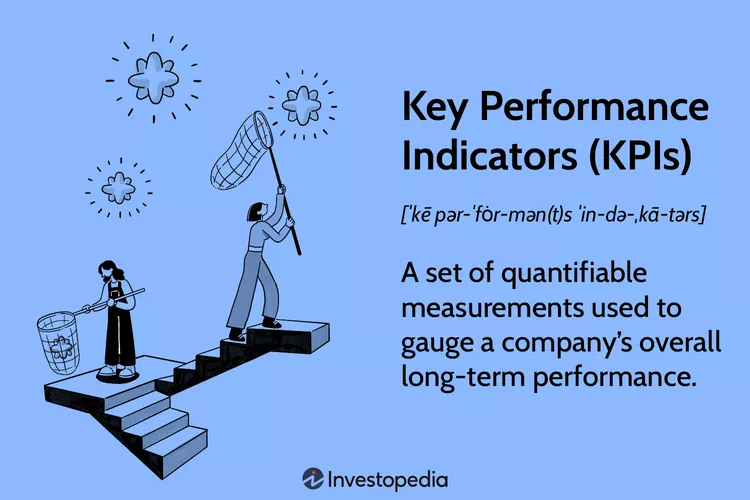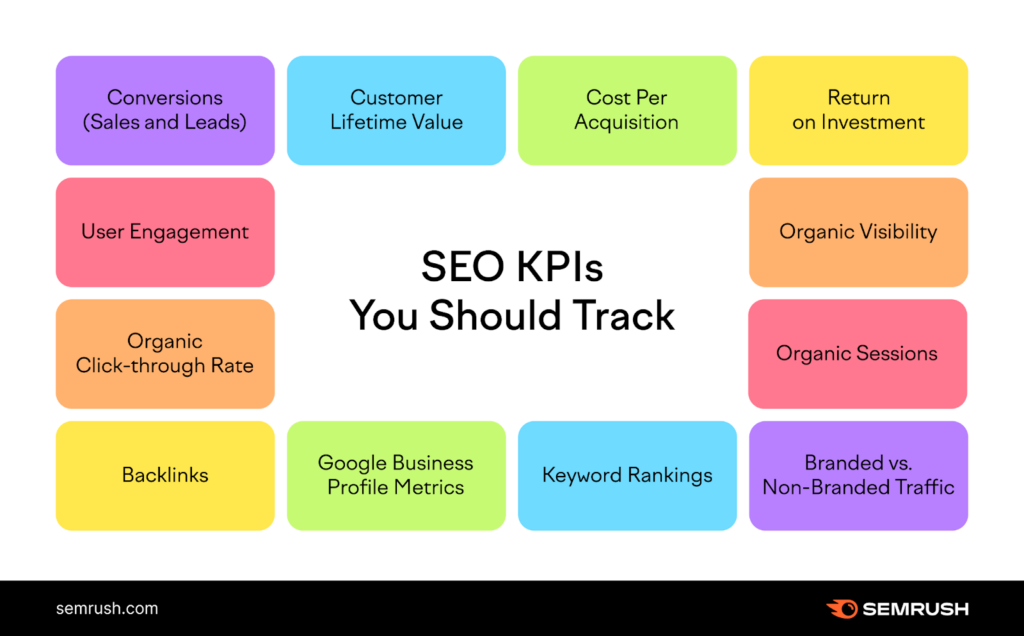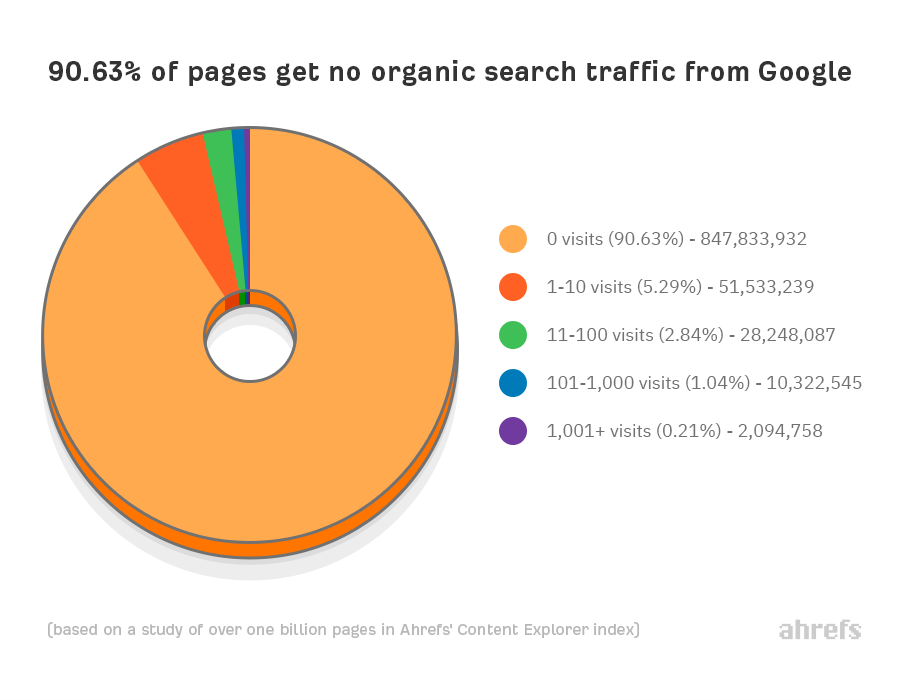There are roughly 3.5 billion searches on Google daily. From desktop to smartphone to voice search, users can connect with a search engine in seconds.
The problem is 54% of all searchers click on the first three search results. If your site isn’t appearing on the first page of a Google search, it’s time to start reviewing your SEO.
Stick with us as we jump into five SEO goals to set and track in 2023 for a SERP score that sticks.
What is a KPI?
When setting SEO goals for the new year, it’s important to plan your strategy with goal measurement in mind. Improving your SERP score is a lengthy process, so it’s important to set manageable and measurable performance goals that will track change over time.
According to Investopedia, “key performance indicators (KPIs) refer to a set of quantifiable measurements used to gauge a company’s overall long-term performance.”

(Image Source: Investopedia)
Whether they are consumer or process-focused, KPIs aim to help a company determine operational, strategic and financial achievements. Taking time to track performance indicators can help a business highlight what they are doing right and, more importantly, what they are doing wrong.
Setting KPIs can give a company reachable goals to work towards and improve the efficiency of the growth process.
Should you set KPIs for your SEO?
The question is, should you set KPIs for strategy specifics such as your SEO?
While it’s important to set long-term company goals, it’s essential that you dive deeper into strategy specifics, such as SEO, conversion optimisation and UX design. Ensuring that all company processes drive tangible results is a great way to make sure the whole business grows in the right direction.
There are a number of SEO KPIs to keep track of in 2023. From user engagement to customer lifetime value, staying on top of your search engine optimisation has never been harder. There are so many factors now at play when it comes to creating a successful site.

(Image Source: SEM Rush)
That’s why each business must take a step back and observe which processes need improving. While one site may have a hefty bounce rate, another could be suffering from poor content engagement. Formulating KPIs based on personalised SEO specifics will lead to a more positive outcome.
“Know what you want from your site, then measure that success,” claims Marketing Analytics Expert Judge Alan K’necht. “See if these successes improve at the same rate or faster than your SEO success.”
If you track the right performance metrics, you’ll be in with a chance of improving your position in a Google Search. Without further ado, here are five trackable SEO indicators to get you started.
1. Domain Authority
Tracking your domain authority is a one-way ticket to understanding your SEO success. Your Domain authority (DA) is a Moz-powered search engine ranking score that lets a business know how well it will rank amongst its competitors on Google. The higher the score, the more likely your site will appear on the first page of a search.
Setting a DA KPI is a great way to measure continued SEO performance. The key here is to review your current score and aim to improve it in small, measurable increments. For example, if you’re currently at DA30, aim to reach DA50 by the end of the year.
One way to do this is to track and measure other important factors, such as keywords and backlinking, both of which affect your DA score considerably.
Did you know that 66% of all site pages have no backlinks? Setting goals to add more backlinks and high search volume keywords to your page content could improve your site authority, in turn raising your DA score.
2. Organic traffic
Another way to improve site ranking is to keep engagement levels climbing. The more people who visit your landing page, the higher Google places it in a search string.
A whopping 53% of all traffic comes from organic search alone, so it’s vital to incorporate it into an actionable KPI indicator. This KPI would measure the amount of traffic your site receives and how much of that comes from an organic search result.
One key SEO objective for all business leaders is to increase the number of people who interact with their content.
Over 90% of site pages receive no organic traffic from Google, while only 5% receive 1-10 visits per month. Keeping track of the pages receiving less engagement gives marketers a chance to optimise the page content for increased engagement. This could include adding more keyworded content and linking out to poorly performing pages on external sites.

(Image Source: Ahrefs)
Working with Google Analytics, you can quickly track daily site searches and measure site traffic levels using the ‘organic traffic’ filter. This could change depending on the search time, location and season, so it’s important to measure your traffic levels at different times of the day, month and year.
3. Bounce rate
While it’s important to measure the traffic that enters your site, it’s even more important to keep track of the traffic that bounces.
Your site bounce rate is the percentage of visitors that click off of your site after viewing only one page. A successful website has a low bounce rate, as consumers tend to navigate from the landing page to the checkout. If you constantly see viewing figures drop after a few clicks, it could be a sign that you need to update your content or improve your page loading time.
Tracking page specifics, such as content loading time, can help determine the cause of a high bounce rate and lead to a quicker positive KPI result.
The key here is to track how long your landing page takes to load. If you want to improve your user experience, make sure it’s no longer than 2-5 seconds. Anything over 10 seconds, and you’ll lose 123% of visitors to your page.
One way to do this is to review your hosting server. Investing in a web host that offers high speeds and no downtime is a great way to keep your bounce rate low.
4. Customer Lifetime Value
Your conversion rate is one of the most crucial SEO KPIs to track in 2023. With more ecommerce competition than ever before, you need to know how many visitors have converted into customers.
One way to stay on top of this is to track your customer lifetime value (CLV). Measuring the amount of revenue each consumer creates, it’s a great way to help a business identify which SEO practices result in the largest financial gain.
“My perspective on using CLV and why it connects to core KPI is because it’s a Unified metric.It forces people who typically focus only on one stage of the funnel to think bigger, to think customer-centric,” says co-founder of MarketMuse, Jeff Coyle.
“Customer Lifetime Value makes them have to care about all the content. It makes them care about customer success, renewals, support and exponential viral growth.”
To do this, focus on consumer goal completion rather than purely conversions alone. Measure how many people sign up for a free trial or sign up for a loyalty program, as well as track the number of visitors who convert.
5. Content Efficiency
SEO revolves around building traffic using content. From high-volume keywords to starting industry conversations, there are a number of ways to draw in consumers using content.
This is why it is important to track your content efficiency, especially when consumers are inundated with blog entries and social media posts.
“My other favourite KPI is content efficiency. It’s about how many content items you publish, how many content items you update and/or optimise versus how often those pages meet their goals and predict ROI.” Coyle continues.
The key here is to track your content engagement using tools such as Ahrefs or Google Analytics. Try and spot patterns within your publishing and work out what content formats are receiving the most visitor engagement.
How to get started
Tracking KPIs has never been easier. With Google Analytics, Moz and Ahrefs at your fingertips, data-driven marketing is the way forward.
Make sure you set up regular tracking of each KPI you set and record the results of your report. As you progress, each report should show a gradual improvement and highlight areas to keep optimising.
While the e-commerce industry may have grown by a third in just three years, staying on top of your performance will improve market understanding and increase your chances of success.

